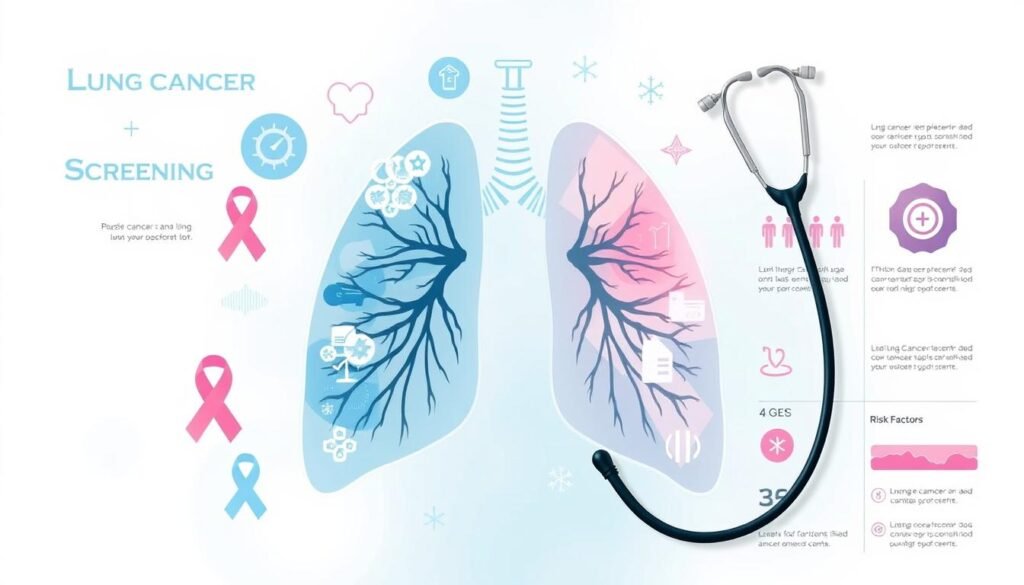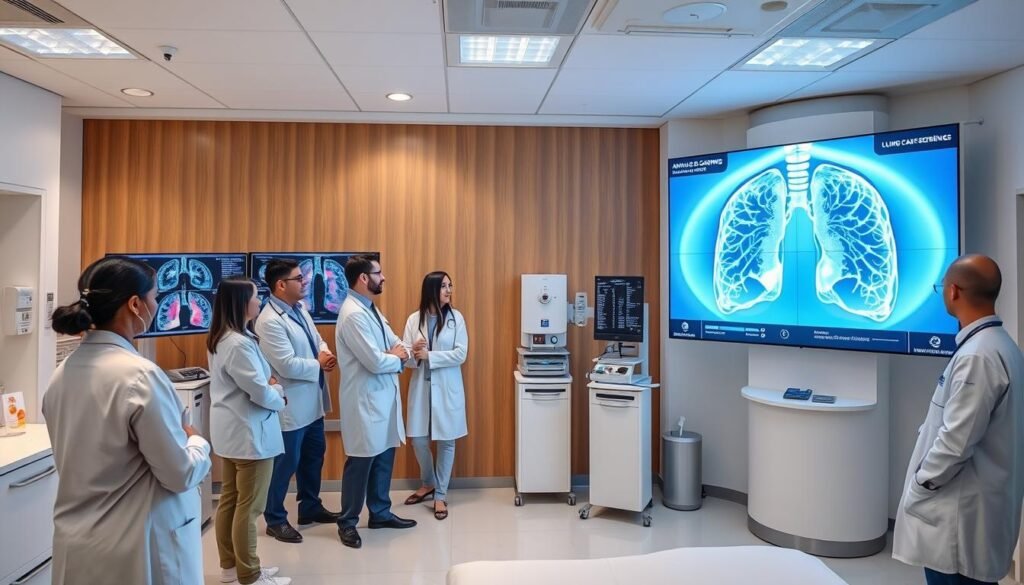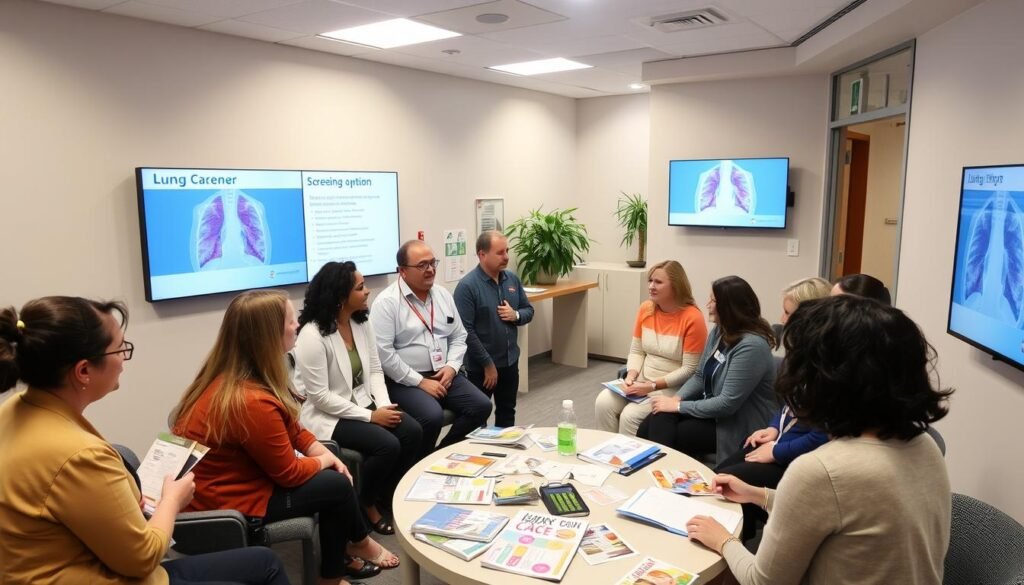The National Lung Screening Trial (NLST) showed surprising results. It found that individuals screened with low-dose CT (LDCT) had a 15 to 20 percent lower chance of dying from lung cancer. These findings highlight the importance of lung cancer screening for early detection.
Such screenings greatly improve survival chances. Having the right info about lung cancer screening lets people make smart health choices. This leads to better management of lung health.
Many are curious about lung health screenings. They wonder about the importance of regular check-ups and what test results mean. This article provides details on lung cancer screening resources, with an emphasis on early detection guidelines.
Understanding these resources is crucial. It’s not just about saving lives. It’s also about improving quality of life by catching lung issues early.
Key Takeaways
- LDCT screening can reduce lung cancer-related deaths by 15 to 20 percent.
- Annual screening is advised for individuals aged 50 to 80 with a history of heavy smoking.
- Most health insurance plans, including Medicare, typically cover the cost of LDCT scans.
- Screening resources are readily available for high-risk patients, including Veterans.
- Early detection through screening is vital for improving treatment outcomes.
Understanding Lung Cancer Screening
Lung cancer screening is a way to find lung cancer early in people without symptoms. Catching lung cancer early can greatly improve the chances of successful treatment. One main method for screening is low-dose computed tomography (LDCT). This technique provides clear lung images with less radiation.
Lung cancer is the top cause of cancer deaths in the U.S. It’s also the second most common non-skin cancer. Smoking is a huge risk factor, causing 90% of lung cancers in men and 80% in women. The National Lung Screening Trial shows LDCT scans lower the death risk from lung cancer in heavy smokers.
Yearly LDCT screenings are more effective than chest x-rays at finding lung cancer early. They’re particularly helpful for adults over 50 who smoked a lot. This includes people who’ve stopped smoking in the last 15 years.
Screening doesn’t just spot lung cancer. It can also uncover other issues like emphysema or heart problems. Many people screened have lung nodules. These don’t always need immediate treatment. Small nodules are often watched, while big ones may need more tests.
Despite its benefits, lung cancer screening has risks. There’s a small exposure to radiation. Sometimes, it leads to more invasive tests. But these risks are minor compared to the benefit of catching lung cancer early.
The Importance of Early Detection
Finding lung cancer early can make a big difference in treatment and survival. Lung cancer is the second most common cancer in the U.S. It’s also the top cause of cancer deaths. Sadly, only 21% of lung cancers are found early. This early stage is when treatments work best.
Low-dose computed tomography (LDCT) scans are a big help in early detection for high-risk people. The American Cancer Society advises yearly LDCT screens for 50 to 80-year-olds who smoked a lot. This helps find lung cancer early, improving the chances of successful treatment and recovery.
Studies show that LDCT scans can lower the risk of dying from lung cancer by 20-25%. This is compared to chest x-rays, which don’t really help most people live longer. LDCT scans are better at finding cancer before any symptoms show. This means doctors can start treatments sooner. However, it’s important these scans are done in places with the right CT scanners and trained staff.
Yet, many who should get LDCT scans don’t. Talking with healthcare providers helps people choose the right screening. This ensures they get care that fits their health needs. People at high risk need to follow lung cancer screening guidelines. These guidelines could save lives.
Lung Cancer Screening Tests Explained
Lung cancer screenings are key for catching it early. The top method used is the LDCT scan. It’s shown to lower deaths from lung cancer by finding more than half of them early. This improves chances of successful treatment a lot, compared to finding only 25% early without screenings. While first-time screenings might have a 12-14% chance of a false alarm, this gets better. It drops to about 6% for those who get checked every year, thanks to comparing results over time.
When you get a LDCT scan, it’s pretty comfortable and quick. It’s a bit like getting six months of sunshine in terms of radiation, which is just a bit more than a mammogram. The experts say people 55 to 80 who smoked a lot or quit recently should get checked every year. These screenings help tell if a lung spot is cancer or not.
New tech has made lung cancer tests even better. They now have fewer false alarms. If you are at high risk, insurance often covers the screening. This makes it easier and cheaper to get screened every year. Doing this is a big step in preventing lung cancer.
| Test | Initial Screening | Annual Screening |
|---|---|---|
| False Positive Rate | 12-14% | 6% |
| Incidental Findings | 6% | 2% |
| Radiation Exposure | Equivalent to 6 months of natural background radiation | Same as initial screening |
| Comparison with Other Screenings | Similar to mammograms and colonoscopies | Recommended annually |
Lung Cancer Screening Guidelines
Lung cancer screening is key in catching this widespread disease early. The US Preventive Services Task Force (USPSTF) has guidelines for who should get screened. They suggest yearly screening with a special type of scan for adults 50 to 80. This is for those who’ve smoked a lot over the years. Most lung cancer cases are due to smoking.
The rules for screening include age and how much someone has smoked. It’s crucial for making smart health choices. Knowing if you fit these screening guidelines can be a lifesaver. Lung cancer’s 5-year survival rate is quite low, at only 20.5%.
However, not enough people are getting screened for lung cancer. A study found just 14.4% of those who should get screened actually did so last year. This shows a big need to make more people aware and improve screening access. Doing so can save lives.
Resources for Lung Cancer Screening Information
Many resources are available to help people looking for info on lung cancer screening. These groups offer key advice on who is eligible, how to go through the screening steps, and getting affordable care. Using these resources helps people understand lung cancer screening better. It makes early detection more likely.
Key Organizations Providing Information
The American Cancer Society and the American Lung Association are top sources for detailed lung cancer screening info. They work to make more people aware of lung cancer screening, especially those at high risk. Their resources explain risk factors, symptoms, and how screening works. Plus, CancerCare and LUNGevity offer special help, like financial aid for families facing cancer costs.
Online Tools and Resources
Today, online tools are key for simplifying the lung cancer screening process. Many websites have interactive tools to check your risk using your health info. They also provide material to help you talk to your doctors. For example, the Magnolia Meals at Home program offers specific help in some areas. These online resources give full details on lung cancer screening, including how to qualify. Adults 50-80 who smoked a lot are advised to get screened yearly. Using these online tools keeps people informed and prepared.
Lung Cancer Screening Recommendations
Lung cancer screening is key for early detection and treatment. The American Cancer Society suggests that those aged 50 to 80 who have smoked a lot should get a yearly low-dose CT scan. If you’ve smoked for at least 20 years, you’re at higher risk and need screening.
A pack-year means smoking a pack a day for a year. Even after quitting, your lung cancer risk stays high for years. It gets lower over time. Screening might also help those who stopped smoking more than 15 years ago, reducing lung cancer deaths.

Doctors say it’s important to check smokers for lung cancer. Low-dose CT scans are good because they don’t expose you to much radiation. New CT technology also helps keep patients safe by using less radiation.
But, some people shouldn’t get screened. This includes you if you smoked less than 30 pack-years, are younger than 55 or older than 77, or stopped smoking more than 15 years ago. Doctors look at your overall health before suggesting screening.
Talking to your doctor about lung cancer screening is important. It helps make sure those at high risk get the right care.
For more details, the American College of Radiology has a lot of information. You can find it here.
| Age Range | Pack-Year History | Recommendation |
|---|---|---|
| 50-80 years | At least 20 | Annual low-dose CT screening |
| Under 55 | Any | No low-dose CT screening |
| Over 77 | Any | No low-dose CT screening |
| Quit over 15 years ago | Any | No low-dose CT screening |
| Comorbid conditions | None specific | No low-dose CT screening |
Who Should Get Screened for Lung Cancer?
Lung cancer screening is for certain people, based on set rules. These rules pick those who are most at risk. This helps in taking steps early to prevent the disease. Knowing if you are eligible is key. It can help find the disease early and increase the chances of surviving.
Eligibility Criteria Set by Health Authorities
Now, people aged 50 to 80 need screening if they smoke or stopped smoking in the last 15 years. They must have smoked the equivalent of 20 pack-years. One pack-year means smoking a pack a day for a year. Thanks to new rules, more individuals, including women and people of color, can get screened.
Risk Factors for Developing Lung Cancer
There are more reasons to consider screening besides smoking. These reasons include:
- Exposure to second-hand smoke
- Air pollution
- Asbestos exposure
- Family history of lung cancer
- Certain workplace fumes and chemicals
- Radon exposure
- Prior radiation therapy
- Chronic use of some immune-suppressing medications
Knowing these risk factors is critical. It helps people find the right resources for lung cancer screening information. Being proactive about screenings can catch the disease early. Often, symptoms don’t appear until the disease has advanced.
Latest Updates on Lung Cancer Screening
The way we screen for lung cancer is changing quickly. New guidelines are using the latest research and technology. The American Cancer Society now suggests annual screenings. They use low-dose CT scans for people 50 to 80 who smoked a lot in the past.
A “pack-year” means smoking a pack a day for a year. It helps doctors figure out someone’s risk.
There’s a new idea to include people who stopped smoking over 15 years ago in screenings. This could help save more lives and extend how long people live. Low-dose CT scans are getting safer with less radiation, making them better for patients.
Experts think we should change who gets screened to help more people. Some evidence suggests we should rethink the 15-year rule for former smokers. Lung cancer is especially deadly for women, more so than breast and ovarian cancers combined. This shows how important it is to have good screening.
Insurance plans are also changing because of the new rules. Both Commercial and State Medicaid plans are making updates. These changes will help more people get screened on time.
Yet, it’s vital for people to know about the downsides of screening too. These include false alarms and sometimes catching things that aren’t harmful. The USPSTF says screening should stop at 81 years old, or if the person hasn’t smoked in 15 years, or if they’re too sick for lung cancer surgery.
To learn more, check out the Lung Cancer Screening FAQ. It has a lot of info about CT scanning. There’s also an Economics & Billing One-Pager that talks about the costs of lung cancer screening. Here’s a table that outlines the current and suggested guidelines:
| Criteria | Current Guidelines | Proposed Changes |
|---|---|---|
| Age | 50-80 years | No change |
| Smoking History | 20 pack-years | Consideration for those who quit >15 years ago |
| Screening Frequency | Yearly | No change |
| Termination of Screening | Age 81 or health issues | No change |

Comprehensive Lung Cancer Screening Information
Lung cancer screening is very important for catching the disease early. This can greatly improve chances of surviving. Patients and healthcare providers can make better choices with access to detailed lung cancer screening info. The Lung Cancer Screening Journey Map gives patients personalized tools. This helps them understand the screening better.
Customizable Resources for Patients
Patient-specific resources are vital for those looking into lung cancer screening. These tools explain the pros and cons of getting screened. They use a journey map to make the experience fit the patient’s needs. It looks at their smoking history and health to see if they qualify for screening. This detailed info lets patients take an active role in their healthcare. It also helps them understand their screening options better.
Education Materials for Healthcare Providers
Healthcare providers need strong educational tools to help patients with lung cancer screening. They need up-to-date info, including the U.S. Preventive Services Task Force’s requirements for yearly scans. Good resources let them educate patients on who can get screened and why early detection is key. For more information on lung cancer, check out the Lung Cancer Policy.
Tips for Finding the Best Lung Cancer Screening Resources
Looking for the best lung cancer screening resources requires a careful approach. Start with well-known health organizations. They give detailed info on when to get screened. The American Cancer Society is a good place to look for this information.
Ask for referrals to certified screening centers. Doctors can guide you to places with top safety and technology standards. Also, finding a center nearby makes it easier to get screened.
Online sites provide fresh research and advice for patients. The US Preventive Services Task Force has guidelines, including who should get screened based on their smoking history and age.
Think about the cost. Insurance usually covers screening costs, and some places offer it free for the uninsured. The American Cancer Society Cancer Action Network helps those struggling financially to get screened.

| Resource Type | Provider | Description |
|---|---|---|
| Health Organizations | American Cancer Society | Offers comprehensive guides and resources for lung cancer screening. |
| Accredited Centers | Local Hospitals | Facilities that meet safety standards and offer screenings. |
| Online Platforms | US Preventive Services Task Force | Provides guidelines on lung cancer screening based on risk factors. |
| Financial Aid | ACS CAN | Resources for individuals who are uninsured or underinsured. |
These tips will help you find the right lung cancer screening resources. They empower you to make informed health decisions.
Conclusion
In the last five years, lung cancer survival rates in the U.S. have gone up by 26% to 28.4%. This is due to early detection. But only 16.0% of those who could get screened did so in 2022. This shows a big gap in using lung cancer screening resources that could save lives.
Annual low-dose CT scans could cut lung cancer deaths by 20%. Yet, not many at-risk people are getting screened. It’s also worth noting that more screening could add 500,000 more years of life. This points to a need for better promotion and information about lung cancer screenings.
Efforts in health systems, especially in places like federally qualified health centers, are key. They help more people get screened and tackle access issues.
It’s very important to raise awareness and get people to be proactive about their health. Talking to doctors about screening options can really make a difference. Making smart choices with the help of good lung cancer screening resources can greatly increase survival and life quality.